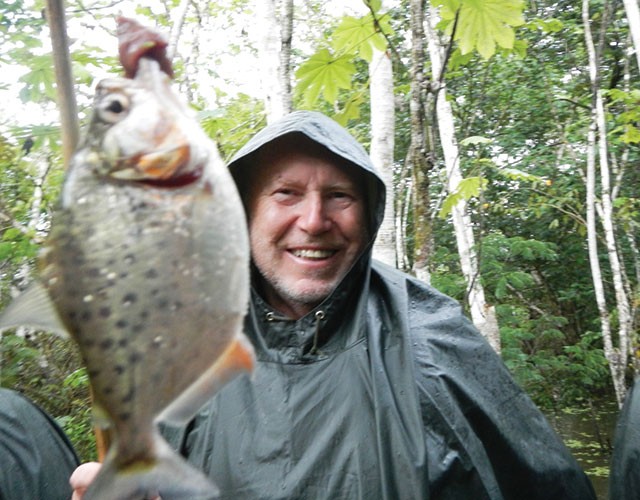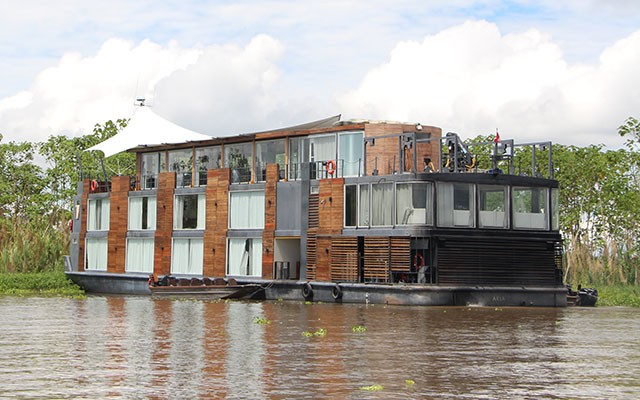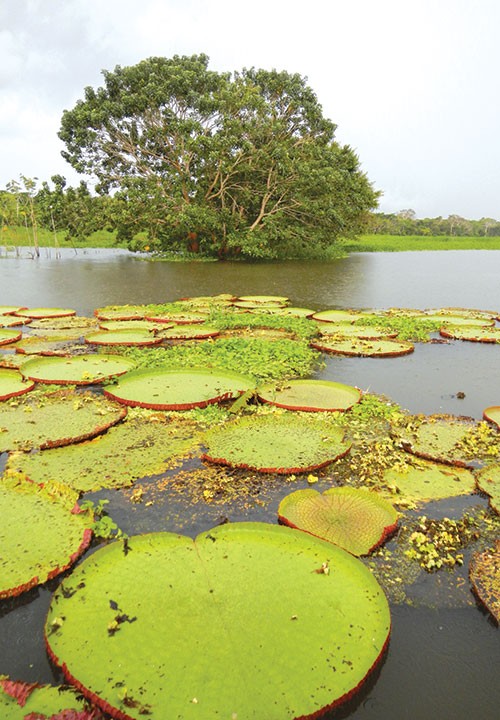The rain is pelting vertically and horizontally when we arrive at the giant lily pads of the Amazon. I am enraptured by the scale and artistry of the organic rafts, but this is just a tantalizing, quick stop in our excursion skiff. We are on a mission. Piranha fishing lies ahead, and most of my seven fellow passengers are geared to catch something more tangible than beauty.
We zoom away until the behemoth pads are only green dots and then gone. The friend travelling with me is encased in the thick rubber poncho Aqua Expeditions provided, so only her bright eyes peek out. Beth looks like she is doing an ad for an all-weather burka. A few days before, she had been a busy mom and film editor on the West Coast. Today, I can see her eyes twinkling with the delicious absurdity that we are in the Amazon, looking for piranha, in the middle of a downpour.

PHOTO BY LISA TE SONNE - Piranha in the foreground to make it a big fishing tale (even if blurry in details)
RAIN
Where are the sloths, anteaters and monkeys now as the sky tumbles down? Where are all the toucans, macaws and pink river dolphins that we have seen in the preceding excursions when no rain plunged? Before all my hunting was for photos. Now our excursion seeks teethy prey underwater.
The staccatoing, tattooing rain continues its wet assault. At full speed we head out in the middle of a wide section of the 6,400-kilometre long Amazon network — there doesn't even seem to be shores, just island clusters of the upper portions of trees in the flooded forests. No signs of other humans.
Then, reading geography foreign to us illiterates, the boat driver heads over to a small opening in a partially submerged forest. As we duck under branches, we joke about what caiman, electric eels and piranha may await in the murky depths.
Our skiff settles amidst trees, and the rain. But falling water doesn't stop the fishermen in us. Our jovial, patient guide, Julio, hands out poles that are long thin pieces of wood with about three metres of line and a simple hook. No reels or flashy lures. He shows us how to use the pole tip to stir an opening between all the aquatic plants, then he baits our hooks with little chunks of beef.

PHOTO BY LISA TE SONNE - Our mothership, the Aria.
A CATCH
As the rain eases away, I find a tranquility floating in the forest. Drips from leaves send ripples over the snatches of trees reflected in the dark waters visible between lush aquatic flora. My mind begins to empty serenely when I feel my pole slightly tugged then jerked enough that my reflexes pull it straight up. There, dangling in the air, is the first catch of the boat — a 10-centimetre piranha with sharp teeth, the renowned man-eating predator of the Amazon. So little.
I am dismayed that this baby fish should end its life so soon, but the guide assures me that it can still live if we release it. We put the fish back, hoping it will live long enough to feed a human family (and not, as rarely known to do, feed on the family).
Protein from fish is a dominant part of the diet of many of the ribereños or "river people" in the Amazon. The piranha teeth are used by some of the locals for weapons and tools. The teeth and spinal chords also add drama to jewelry sold to visitors.

PHOTO BY LISA TE SONNE - A monkey enjoys some sunshine before the rain starts falling.
MORE CATCHES
Another woman on the boat pulls a respectable sized, red-bellied piranha into the air, and the fish seems to fly off the hook with gravity aiding its escape. Five minutes later, she does it again. The guide says the two fish count. I suggest we are implementing a very efficient system of "catch and release." Why bother the fish with human hands?
An action-oriented passenger onboard narrates the number of piranha he can actually see in his little opening through the plants, as the intended prey cleverly nibble the bait in a way that eludes any hooking. We are losing bait at such a rapid rate, we joke that we are using two pounds of cow to seek 10 ounces of fish.
The quietest passenger onboard catches and brings in a 15-centimetre piranha, and Julio directs him to pose with the captor far in the foreground to let it grow to the size of a good fish tale. Julio then holds the catch carefully so we can all see the very sharp teeth of this flesh-eating river fish, and he helps us take photos of the teeth so we each have a visual trophy of our outing.
That fish too returns to nature's pantry — not big enough yet for much human sustenance. At last, our dear guide confesses that the local people don't bother fishing this time of year, when the waters are high. This is the high season, when the piranha-fishing prospects are low.
This time of year, the river people, we're told, rely on fish they caught and salted when the fishing was good — when all that we are floating over was dry land. Salt here in this fresh-water part of the world is a valued commodity, and one of the only resources needed from outer realms.
Had we booked our Amazon trip via Austin Adventures during the low season"(June to November), when river waters can be as much as nine metres lower, we would have gone to different fishing holes. We might have proved much more successful as fishermen and brought back dinner — or not.
Beth and I and our fellow passengers know this "piranha fishing" experience has been created for us, one of our many peeks at Amazon life. Unlike some of the indigenous people in this area, our food supply and health and families don't depend on it.
When we return to the Aria, our marvellous "mothership" (quite different than the wooden dug outs paddled by locals), a superb chef will have a taster's menu of exemplary Peruvian food. We will leave our muddy shoes out to be cleaned by others, and pad to the rain showers in our suites with floor-to-ceiling windows, or slip into the soothing Jacuzzi at the front of our luxurious boat.
But for some moments in our being, we were in the rain and hunting the piranha. The fishing gave us pause to contemplate how other people live — closer to the songs and stings, and the magic and mood swings of nature.

PHOTO BY LISA TE SONNE - Giant lily pads of the Amazon.
READY TO GO
June to November for the Amazon is the low season of water levels when the chances of catching piranha fish is high. Austin Adventures, which customizes trips worldwide, offers Amazon packages that can include other destinations like Machu Picchu in Peru. www.austinadventures.com/packages/peru-amazon-river-cruise/
Aqua Expeditions offers year-round Amazon cruises, four a week, in both the high season and the low season when your fishing chances are much better. They also now offer Mekong Cruises 48 weeks of the year. www.aquaexpeditions.com/upcoming-cruises/




